- Home
- Robert Graves
Hebrew Myths: The Book of Genesis
Hebrew Myths: The Book of Genesis Read online
Hebrew Myths
The Book of Genesis
Robert Graves
Copyright
Hebrew Myths
Copyright © 1964 by The Trustees of the Robert Graves Copyright Trust and Daphne Patai
Copyright © 1963, 1964 by International Authors NV and Dr Raphael Patai, renewed 1992 by Beryl Graves and Dr Raphael Patai
Cover art, special contents, and Electronic Edition © 2014 by RosettaBooks LLC
All rights reserved. No part of this book may be used or reproduced in any form or by any electronic or mechanical means, including information storage and retrieval systems, without permission in writing from the publisher, except by a reviewer who may quote brief passages in a review.
Cover jacket design by Carly Schnur
ISBN e-Pub edition: 9780795337154
CONTENTS
INTRODUCTION
1 THE CREATION ACCORDING TO GENESIS
2 THE CREATION ACCORDING TO OTHER BIBLICAL TEXTS
3 MYTHICAL COSMOLOGY
4 GLOSSES ON THE CREATION STORY
5 EARLIER CREATIONS
6 THE PRIMEVAL MONSTERS DESCRIBED
7 THE REEM AND THE ZIZ
8 THE FALL OF LUCIFER
9 THE BIRTH OF ADAM
10 ADAM’S HELPMEETS
11 PARADISE
12 THE FALL OF MAN
13 SAMAEL’S REBELLION
14 THE BIRTHS OF CAIN AND ABEL
15 THE ACT OF LOVE
16 THE FRATRICIDE
17 THE BIRTH OF SETH
18 THE SONS OF GOD AND THE DAUGHTERS OF MEN
19 THE BIRTH OF NOAH
20 THE DELUGE
21 NOAH’S DRUNKENNESS
22 THE TOWER OF BABEL
23 ABRAHAM’S ANCESTRY
24 ABRAHAM’S BIRTH
25 ABRAHAM AND THE IDOLS
26 ABRAHAM IN EGYPT
27 ABRAHAM’S RESCUE OF LOT
28 THE SEVERED CARCASES
29 ISHMAEL
30 ABRAHAM IN GERAR
31 THE BIRTH OF ISAAC
32 LOT AT SODOM
33 LOT AT ZOAR
34 THE SACRIFICE OF ISAAC
35 ABRAHAM AND KETURAH
36 ISAAC’S MARRIAGE
37 ISAAC IN GERAR
38 THE BIRTHS OF ESAU AND JACOB
39 ABRAHAM’S DEATH
40 THE BARTERED BIRTHRIGHT
41 THE STOLEN BLESSING
42 ESAU’S MARRIAGES
43 JACOB AT BETHEL
44 JACOB’S MARRIAGES
45 BIRTH OF THE TWELVE PATRIARCHS
46 JACOB’S RETURN TO CANAAN
47 JACOB AT PENIEL
48 RECONCILIATION OF JACOB AND ESAU
49 THE RAPE OF DINAH
50 REUBEN AND BILHAH
51 JUDAH AND TAMAR
52 THE DEATHS OF ISAAC, LEAH, AND ESAU
53 JOSEPH IN THE PIT
54 JOSEPH AND ZULEIKA
55 JOSEPH IN PRISON
56 JOSEPH BECOMES VICEROY
57 THE FAMINE
58 THE BROTHERS’ RETURN
59 JACOB IN EGYPT
60 THE DEATH OF JACOB
61 THE DEATH OF JOSEPH
MAPS
THE WORLD OF GENESIS
ABRAHAM’S WORLD
PALESTINE UNDER THE JUDGES
INTRODUCTION
Myths are dramatic stories that form a sacred charter either authorizing the continuance of ancient institutions, customs, rites and beliefs in the area where they are current, or approving alterations. The word ‘myth’ is Greek, mythology is a Greek concept, and the study of mythology is based on Greek examples. Literalists who deny that the Bible contains any myths at all are, in a sense, justified. Most other myths deal with gods and goddesses who take sides in human affairs, each favouring rival heroes; whereas the Bible acknowledges only a single universal God.
All pre-Biblical sacred documents in Hebrew have been either lost or purposely suppressed. They included The Book of the Wars of Yahweh and the Book of Yashar, epic accounts of the Israelites’ desert wanderings and their invasion of Canaan. That these books were written in the early poetic Hebrew style, can be seen from the brief fragments quoted from them in Numbers XXI. 14; Joshua X. 13 and 2 Samuel I. 18. A third book, reputedly compiled in seven parts at Joshua’s orders, described Canaan and its cities (Joshua XVIII. 9). The Book of the Story of Adam (Genesis V. 1) suggests a detailed account of the first ten generations from Adam to Noah. The Book of Yahweh (Isaiah XXXIV. 16) seems to have been a mythological bestiary. Several other lost books mentioned in the Bible, such as the Acts of Solomon, the Book of Genealogy, the Chronicles of the Kings of Judah, Of the Kings of Israel, Of the Sons of Levi, must have contained many mythic references.
Post-Biblical sacred documents are abundant. In the thousand years after the Bible was first canonised, the Jews of Europe, Asia and Africa wrote prolifically. Theirs were either attempts to clarify the Mosaic Law; or historical, moralistic, anecdotal and homiletic comments on Biblical passages. In both cases the authors included much mythic material, because myth has always served as a succinct validation of puzzling laws, rites and social customs.
Now, although the canonical books were regarded as written by divine inspiration and the least taint of polytheism had therefore to be exorcized from them, the apocryphal books were treated more leniently. Many suppressed myths were also allowed to re-emerge in the unquestionably orthodox context of the post-Biblical midrashim. For example in Exodus we read that Pharaoh’s horses, chariots and horsemen pursued the Children of Israel into the midst of the sea (Exodus XIV. 23). According to one midrash (Mekhilta diR. Shimon 51, 54; Mid. Wayosha 52) God assumed the shape of a mare and decoyed the ruttish Egyptian stallions into the water. If the mare-headed Goddess Demeter had been described as drowning King Pelops’s chariotry in the River Alpheus by such a ruse, this would have been acceptable Greek myth; but to the pious reader of the midrash it was no more than a fanciful metaphor of the lengths to which God could go in protecting His Chosen People.
The Bible itself allows us only brief hints of its lost mythological riches. Often the reference is so terse that it passes unnoticed. Few, for instance, who read: ‘And after him was Shamgar ben Anath who smote of the Philistines six hundred men with an ox-goad, and he also saved Israel’ (Judges III. 31), connect Shamgar’s mother with the bloodthirsty Ugaritic Love-goddess, the maiden Anath, in whose honour Jeremiah’s priestly town of Anathot was named. The myth of Shamgar is irrecoverable, yet he must have inherited his virgin mother’s warlike prowess; and the ox-goad with which he smote the Philistines was doubtless a gift from her father, the Bull-god El.
Genesis nevertheless still harbours vestigial accounts of ancient gods and goddesses—disguised as men, women, angels, monsters, or demons. Eve, described in Genesis as Adam’s wife, is identified by historians with the Goddess Heba, wife of a Hittite Storm-god, who rode naked on a lion’s back and, among the Greeks, became the Goddess Hebe, Heracles’s bride (see 10. 10). A prince of Jerusalem in the Tell Amarna period (fourteenth century B.C.) styled himself Abdu-Heba—‘servant of Eve’ (see 27. 6). Lilith, Eve’s predecessor, has been wholly exorcized from Scripture, though she is remembered by Isaiah as inhabiting desolate ruins (see 10. 6). She seems, from midrashic accounts of her sexual promiscuity, to have been a fertility-goddess, and appears as Lillake in a Sumerian religious text, Gilgamesh and the Willow Tree (see 10. 3–6).
There are pre-Biblical references to the angel Samael, alias ‘Satan’. He first appears in history as the patron god of Samal, a small Hittite-Aramaic kingdom lying to the east of Harran (see 13. 1). Another faded god of Hebrew myth is Rahab, the Prince of the Sea, w
ho unsuccessfully defied Jehovah (‘Yahweh’), the God of Israel—much as the Greek God Poseidon defied his brother, Almighty Zeus. Jehovah, according to Isaiah, killed Rahab with a sword (see 6. a). A Ugaritic diety worshipped as Baal-Zebub, or Zebul, at Ekron was consulted by King Ahaziah (2 Kings 1. 2 ff) and centuries later the Galileans accused Jesus of traffic with this ‘Prince of the Demons.’
Seven planetary deities, borrowed from Babylon and Egypt, are commemorated in the seven branches of the Menorah, or sacred candlestick (see 1. 6). They were combined into a single transcendental deity at Jerusalem—as among the Heliopolitans, the Byblians, the Gallic Druids and the Iberians of Tortosa. Scornful references to gods of enemy tribes humiliated by Jehovah occur throughout the historical books of the Bible: such as the Philistine Dagon, Chemosh of Moab, and Milcom of Ammon. Dagon, we know from Philo Byblius to have been a planetary power. But the God of Genesis, in the earliest passages, is still indistinguishable from any other small tribal godling (see 28. 1).
Greek gods and goddesses could play amusing or dramatic parts while intriguing on behalf of favoured heroes, because the myths arose in different city-states which wavered between friendship and enmity. Yet among the Hebrews, once the Northern Kingdom had been destroyed by the Assyrians, myths became monolithic, and centred almost exclusively on Jerusalem.
In Biblical myth, the heroes sometimes represent kings, sometimes dynasties, sometimes tribes. Jacob’s twelve ‘sons’, for instance, seem to have been once independent tribes which banded together to form the Israelite amphictyony or federation. Their local gods and populations were not necessarily of Aramaean race, though ruled by an Aramaean priesthood. Only Joseph can be identified, in part, with a historical character. That each of these ‘sons’, except Joseph, is said to have married a twin-sister (see 45. f), suggests land-inheritance through the mother even under patriarchal government. Dinah, Jacob’s only daughter born without a twin, is best understood as a semi-matriarchal tribe included in the Israel confederacy. The Genesis account of her rape by Shechem and the midrash about her subsequent marriage to Simeon should be read in a political, not a personal, sense (see 29. 1–3).
Other hints of an ancient matriarchal culture occur in Genesis: such as the right of a mother to name her sons, still exercised among the Arabs, and matrilocal marriage: ‘Therefore shall a man leave his father and mother and cleave unto his wife’ (Genesis II. 24). This Palestinian custom is proved by the account in Judges of Samson’s marriage to Delilah; and explains why Abraham, the Aramaean patriarch who entered Palestine with the Hyksos hordes early in the second millennium B.C., ordered his servant Eliezer to buy Isaac a bride from his own patrilocal kinsmen of Harran—rather than let him marry a Canaanite woman, and be adopted into her clan (see 36. 1). Abraham had already sent away the sons borne to him by his concubines, lest they should inherit jointly with Isaac (see 35. b). Matrilocal marriage is the rule in early Greek myth, too: one mythographer records that the first to defy this tradition was Odysseus, who carried Penelope away from Sparta to Ithaca; and that she returned to Sparta after their divorce.
Just how powerful goddesses were under the Jewish monarchy can be seen from Jeremiah’s denunciation of his co-religionists who attributed Judaea’s downfall to their breach of faith with Anath and cried: ‘Let us once more worship the Queen of Heaven, as our fathers did before us!’
Every ruler who reforms national institutions or, like King Josiah, has reforms pressed upon him, must either write a codicil to the old religious charter, or produce a new one; and this involves the manipulation or complete re-writing of myths. It became clear that if Judaea—a small buffer state between Egypt and Assyria—was to keep its political independence, a stronger religious discipline must be inculcated, and the people trained in handling arms. Hitherto most Israelites had embraced the easy-going Canaanite cult in which goddesses played the leading rôle, with kings as their consorts. This, though all very well in peaceful times, could not steel the Jews to resist the invading armies of Egypt and Assyria. A small, tough Israelite minority was led by the Guild of Prophets who made a point of dressing as shepherds or herdsmen in honour of their pastoral God. These prophets saw that Israel’s sole hope of national independence lay in an authoritarian monotheism, and ceaselessly declaimed against goddess-worship in the Canaanite sacred groves. The Book of Deuteronomy, published under Josiah, bans numerous Canaanite rites, among them ritual prostitution, ritual sodomy, and all forms of idolatry. The subsequent demise of the Davidic crown converted all the Babylonian exiles to this view. When Zerubbabel rebuilt Jehovah’s temple, He no longer had any competitors. The Baals, Astartes, Anaths and all the other old Canaanite deities were dead so far as the Judaeans returning from captivity were concerned. Genesis, which is far more closely linked with Greek, Phoenician, Hittite, Ugaritic, Sumerian and other bodies of myth than most pious Jews and Christians care to admit, was thereafter edited and re-edited from perhaps the sixth century B.C. onwards, for moralistic ends. The Ham myth was once identical with that of the conspiracy against the shameless god Cronus by his sons Zeus, Poseidon and Hades: Zeus, the youngest, alone dared castrate him, and as a result became King of Heaven. But Ham’s (or Canaan’s) castration of Noah has been excised from Genesis just before the line: ‘Noah awoke from his wine, and knew what his little son had done unto him.’ The revised version, a moral lesson in filial respect, sentences Ham to perpetual servitude under his elder brothers for no worse a crime than accidentally seeing his father’s nakedness (see 21. 1–4).
Yet the Biblical editors had been careless about excising all favourable mention even of human sacrifice (see 47. 11) and the idolatrous worship of teraphim (see 46. 2). Tabernacles, a Canaanite vintage feast, could not be suppressed but only purged of sexual abandon, and converted to the joyful worship of a Supreme God by being associated with the Israelite use of tents in the Wilderness; even so, the light-headedness of women devotees continued to trouble Pharisee sages. The Canaanite feast of unleavened bread was similarly converted into a commemoration of Israel’s Exodus from Egypt.
A main theme of Greek myth is the gradual reduction of women from sacred beings to chattels. Similarly, Jehovah punishes Eve for causing the Fall of Man. Further to disguise Eve’s original godhead—her title ‘Mother of All Living’ survives in Genesis—the mythographers represented her as formed from Adam’s rib, an anecdote based apparently on the word tsela, meaning both ‘rib’ and ‘a stumbling’. Still later mythographers insisted that she was formed from Adam’s barbed tail… (see 10. 9). The Greeks, too, made woman responsible for man’s unhappy lot by adopting Hesiod’s fable of Pandora’s jar, from which a Titan’s foolish wife let loose the combined spites of sickness, old age and vice. ‘Pandora’—‘all gifts’—it should be observed, was once a title of the Creatrix.
Greek myths account for curses and taboos still in force after a thousand years; and the Greek Hell contained warning instances of criminals punished, like Tantalus, for eating forbidden food; like the Danaids, for husband murder; like Peirithous, for the attempted seduction of a goddess. Yet the Greeks never glossed their myths with pietistic comment: such as that Abraham’s attempted sacrifice of Isaac took place on the first of Tishri, when all Israel blows a ram’s horn to remind God of Abraham’s piety and implore forgiveness of their sins. Or that the Feast of Atonement scapegoat commemorates Jacob’s deception by the Patriarchs when they sprinkled Joseph’s long-sleeved tunic (or ‘coat of many colours’) with blood of a kid (see 53. 3). Although the Isaac myth is paralleled in the Greek account of Athamas’s attempted sacrifice to Zeus of his son Phrixus—a sacrifice interrupted by Heracles’s arrival and the divine appearance of a ram—this occasion was remembered only because the ram supplied the Golden Fleece for which Jason’s Argonauts eventually sailed in quest. Genesis presents it as the crucial episode in Hebrew history (see 34. 9).
Nor were the Greek myths used as texts for political sermonizing. The account of Esau’s ill-treatment at Jacob’s ha
nds was later rounded off by a prophecy that he would one day break Jacob’s yoke from off his neck—an addition clearly intended to justify an Edomite revolt against Judaea in King Joram’s reign (see 40. 3). This text was given a new meaning when the Roman invaders crowned Herod the Wicked, an Edomite, King of the Jews: Edom then became a synonym for ‘Rome’, and the Pharisees counselled the Jews to make no armed rebellion but to expiate their ancestor’s ill-treatment of Esau with patience and forbearance (see 40. 4). A full historical prescience was attributed to Israelite heroes, including a fore-knowledge of the Mosaic Law; and whoever in the Scriptures performs any solemn act is understood to be thereby determining the fate of his descendants for all eternity. Thus when Jacob, on his way to meet Esau, divides his household and cattle into three groups, sending gifts with each at intervals, he is warning his descendants that they should always prudently guard against the worst. According to the midrash, Jacob prayed: ‘Lord, when afflictions descend upon my children, pray leave an interval between them, as I have done!’ (see 47. 2). And the apocryphal Testaments of the Twelve Patriarchs credits these patriarchs with a precise knowledge of later history.
The Jacob myth illustrates another difference between Greek and Hebrew religious attitudes. He steals flocks and herds from his kinsman by altering their colour; the Greek hero Autolycus does likewise; and these two myths apparently have the same Palestinian source. Autolycus is a clever thief, and no more; but since Jacob, re-named Israel, was to become the saintly ancestor of all Jews, his deceit has been justified on the ground that Laban had twice cheated him. And, instead of using vulgar magic, as Autolycus did, on animals already the property of others, Jacob conditions their colour and establishes his ownership of them by studied use of pre-natal influences—the lesson being that Jews may defend themselves against oppressors by legitimate means only (see 46. 1).
No moral conclusions were drawn from the deeds of Greek heroes, unless it were a warning against fortune’s fickleness. Whereas the destruction of Troy brought nothing but ill-luck on every important Greek leader, and famous warriors of an earlier generation, such as Theseus and Bellerophon, had been destined to end miserably, victims of divine nemesis, yet Abraham, Isaac, Jacob and Joseph died in peaceful old age and were honourably gathered to their fathers. This contrast is sharpened when we recall that the story of Joseph and Potiphar’s wife Zuleika is identical with that of Bellerophon and his step-mother Anteia (see 54. 1). Major Hebrew prophets were likewise blessed: Enoch and Elijah rose straight to Heaven; but the Greek seer Teiresias foresaw the doom of Thebes and died in ignoble flight. And although Moses, who rescued his people from the Egyptian Sphinx—namely, the power of Pharaoh—had to expiate a particular fault on Mount Pisgah, he was honourably mourned by all Israel and buried by God Himself; whereas Oedipus, who saved his people from the Theban Sphinx, and had much the same nativity as Moses, died in miserable exile hounded by the Furies of Mother-right.

 The Greek Myths, Volume2
The Greek Myths, Volume2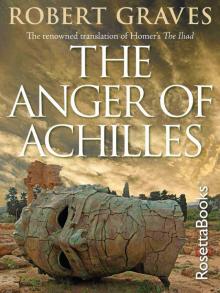 The Anger of Achilles: Homer's Iliad
The Anger of Achilles: Homer's Iliad Count Belisarius
Count Belisarius The Twelve Caesars
The Twelve Caesars Complete Poems 3 (Robert Graves Programme)
Complete Poems 3 (Robert Graves Programme)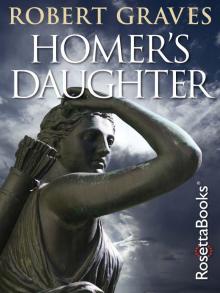 Homer's Daughter
Homer's Daughter The White Goddess
The White Goddess Goodbye to All That
Goodbye to All That Claudius the God and His Wife Messalina
Claudius the God and His Wife Messalina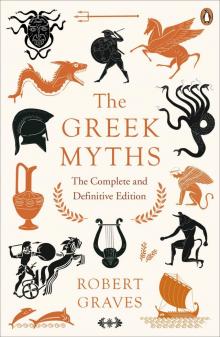 The Greek Myths
The Greek Myths I, Claudius
I, Claudius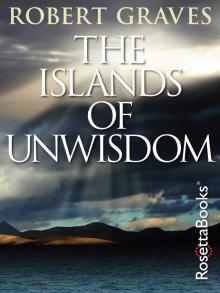 The Islands of Unwisdom
The Islands of Unwisdom Complete Short Stories
Complete Short Stories The Golden Fleece
The Golden Fleece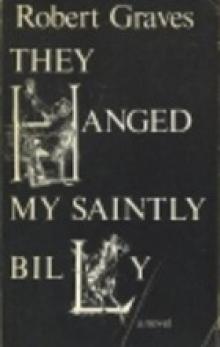 They Hanged My Saintly Billy
They Hanged My Saintly Billy King Jesus
King Jesus Sergeant Lamb's America
Sergeant Lamb's America Hebrew Myths: The Book of Genesis
Hebrew Myths: The Book of Genesis Seven Days in New Crete
Seven Days in New Crete Proceed, Sergeant Lamb
Proceed, Sergeant Lamb Claudius the God
Claudius the God Wife to Mr. Milton
Wife to Mr. Milton The Complete Poems
The Complete Poems The Anger of Achilles
The Anger of Achilles Claudius the God c-2
Claudius the God c-2 Hebrew Myths
Hebrew Myths I, Claudius c-1
I, Claudius c-1 The Greek Myths, Volume 1
The Greek Myths, Volume 1